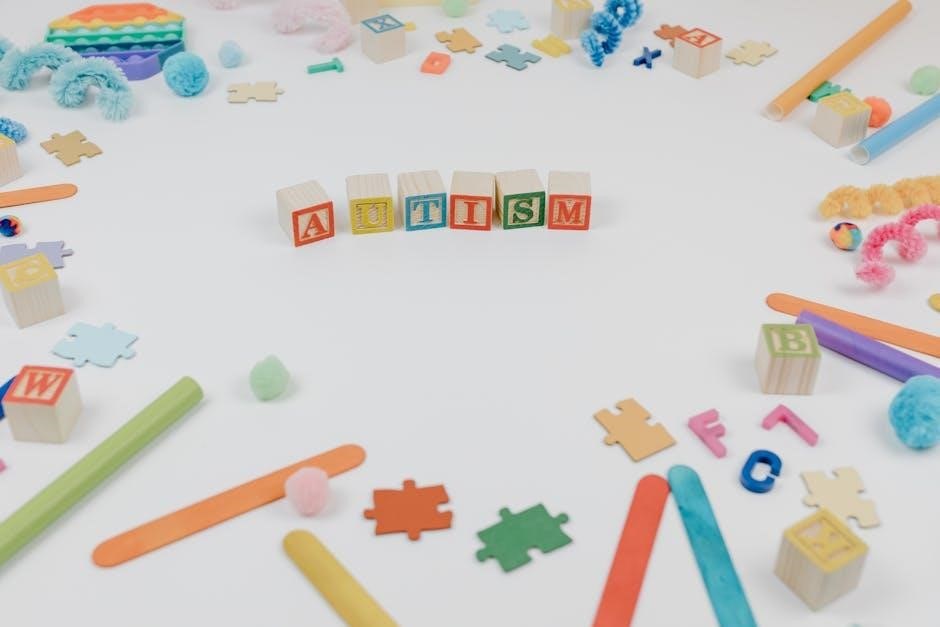The Peabody Developmental Motor Scales (PDMS) is a comprehensive assessment tool evaluating gross and fine motor skills in children from birth to 5 years.
1.1 Overview of the PDMS-2
The PDMS-2 is a standardized assessment tool evaluating gross and fine motor skills in children from birth to 5 years. It includes six subtests: Reflexes, Stationary, Locomotion, Object Manipulation, Grasping, and Visual-Motor Integration. The test provides a Total Motor Quotient (TMQ) and percentile rankings, helping identify developmental delays and plan interventions. It is widely used in clinical and educational settings, offering both criterion-referenced and norm-referenced scoring.
1.2 Importance of Motor Skills Assessment in Early Childhood
Assessing motor skills in early childhood is crucial for identifying delays and supporting developmental needs. Early detection through tools like the PDMS-2 enables timely interventions, promoting better outcomes. Motor skills are foundational for physical coordination, cognitive development, and social interactions, making their evaluation essential for overall child development and educational readiness, aligning with clinical and educational goals.

History and Development of the PDMS
The Peabody Developmental Motor Scales (PDMS) was first introduced in 1983, with the second edition (PDMS-2) released in 2000, and the third edition (PDMS-3) in 2023.
2.1 The Original PDMS (1983)
The original Peabody Developmental Motor Scales (PDMS) was introduced in 1983 as a standardized tool to assess motor skills in children from birth to 5 years. It included subtests such as Reflexes, Stationary, Locomotion, and Object Manipulation, focusing on both gross and fine motor development. This foundational version provided a structured method for evaluating early childhood motor abilities, setting the stage for later revisions.
2.2 Evolution to PDMS-2 (2000)
The PDMS-2, introduced in 2000, is a revised version of the original 1983 assessment. It includes six subtests: Reflexes, Stationary, Locomotion, Object Manipulation, Grasping, and Visual-Motor Integration. This edition provides a more comprehensive evaluation of gross and fine motor skills, offering both criterion-referenced and norm-referenced measures. It is standardized for children from birth to 5 years, enhancing accuracy and scope.

Components of the PDMS-2
The PDMS-2 includes six subtests: Reflexes, Stationary, Locomotion, Object Manipulation, Grasping, and Visual-Motor Integration. These assess both gross and fine motor skills in children from birth to 5 years.
3.1 Subtests and Their Focus Areas
The PDMS-2 consists of six subtests: Reflexes, Stationary, Locomotion, Object Manipulation, Grasping, and Visual-Motor Integration. Each subtest evaluates specific motor abilities, such as balance, movement, hand-eye coordination, and dexterity, providing a comprehensive assessment of both gross and fine motor skills in children from birth to five years old.
3.2 Gross Motor vs. Fine Motor Skills
The PDMS-2 distinguishes between gross motor skills, involving large muscle groups for activities like walking and balance, and fine motor skills, focusing on smaller muscles for tasks like drawing. Both are essential for overall motor development, with the assessment providing separate evaluations to identify strengths and areas needing support in each domain.

Administration and Scoring
Administration requires trained examiners and a controlled environment. Scoring uses standardized criteria and age-based norms to evaluate motor abilities, ensuring reliable and consistent assessment results.
4.1 Examiner Qualifications and Training
Examiners must be trained professionals, such as occupational therapists or psychologists, with expertise in motor development. They should complete specialized workshops or certifications to ensure accurate test administration and scoring. Proper training enables examiners to interpret results effectively and provide reliable assessments of a child’s motor abilities, ensuring consistency and validity in the evaluation process.
4.2 Testing Environment and Materials
The testing environment should be quiet, safe, and free from distractions to ensure accurate assessment. Materials include a soft surface for floor activities, toys for object manipulation, and standardized tools like balls and blocks. The examiner must ensure all materials are clean, age-appropriate, and in good condition to facilitate valid and reliable results, adhering to the test’s specific requirements.
4.3 Scoring Criteria and Norms
The PDMS-2 uses standardized scoring criteria, with each subtest scored based on observed performance. Norms are derived from a large, diverse sample of children. The Total Motor Quotient (TMQ) is calculated by combining gross and fine motor subtest scores. Percentiles and descriptive ratings (e.g., “average,” “below average”) provide interpretive frameworks. Examiners must adhere to strict scoring guidelines to ensure reliability and validity.

Interpretation of Results
Results are interpreted using the Total Motor Quotient (TMQ), percentiles, and descriptive ratings. These metrics provide insights into a child’s motor abilities relative to peers, aiding diagnostic decisions.
5.1 Total Motor Quotient (TMQ)
The Total Motor Quotient (TMQ) is a composite score combining gross and fine motor abilities. It provides a comprehensive measure of a child’s motor skills, offering insights into their developmental status. The TMQ is derived from subtest scores, with a mean of 100 and a standard deviation of 15, allowing for standardized interpretation and comparison to peers.
5.2 Percentiles and Descriptive Ratings
Percentiles and descriptive ratings provide a clear interpretation of a child’s motor performance. Percentile ranks indicate how a child compares to peers, while descriptive ratings categorize skills as average, above, or below expectations. These tools help identify developmental delays and monitor progress over time, offering a framework for targeted interventions and support.

Clinical Applications of the PDMS-2
The PDMS-2 is widely used in clinical settings to diagnose motor delays, plan interventions, and monitor developmental progress in children, aiding therapists and educators in tailored support strategies.
6.1 Diagnosis and Intervention Planning
The PDMS-2 provides detailed motor assessments, enabling professionals to identify delays or disorders. By evaluating gross and fine motor skills, it aids in diagnosing conditions like cerebral palsy or developmental coordination disorder. Results guide the creation of targeted intervention plans, focusing on enhancing specific motor abilities and improving overall developmental outcomes for children. This tool supports early, effective intervention strategies.
6.2 Monitoring Developmental Progress
The PDMS-2 enables longitudinal tracking of motor development, allowing professionals to monitor progress over time. By assessing skills at different ages, it helps identify improvements or persistent delays. Detailed scores and norms enable goal setting and adjustment of interventions, ensuring tailored support for children as they develop. This tool is invaluable for ongoing assessment in clinical and educational settings.
PDMS-2 PDF Resources
PDMS-2 offers downloadable PDF resources, including scoring sheets, charts, and interpretation guidelines, to facilitate accurate assessment and tracking of motor skills development in children.
7.1 Scoring Sheets and Charts
The PDMS-2 provides downloadable PDF scoring sheets and charts for assessing gross and fine motor skills. These resources include subscales, items, scoring criteria, and space for comments. The charts offer a visual representation of developmental milestones, allowing tracking of progress from birth to 7 years. They are essential for accurate evaluation and documentation of motor abilities, ensuring comprehensive assessment and intervention planning.
7.2 Interpretation Guidelines
The PDMS-2 offers detailed interpretation guidelines in PDF format, helping professionals understand test results. These guidelines explain how to derive the Total Motor Quotient (TMQ), interpret percentiles, and apply descriptive ratings. They also provide frameworks for identifying developmental delays and planning interventions, ensuring accurate and meaningful assessment outcomes for children’s motor skills development from birth to 7 years old effectively.
Comparison with Other Motor Assessments
PDMS-2 is often compared to Bayley Scales and the Miller Assessment for Preschoolers, emphasizing its focus on both gross and fine motor skills evaluation in early childhood.
8.1 Bayley Scales of Infant Development
The Bayley Scales of Infant Development assess cognitive, motor, and language skills in infants and toddlers, differing from PDMS-2 by including a broader developmental scope and age range.
8.2 Miller Assessment for Preschoolers
The Miller Assessment for Preschoolers evaluates motor, cognitive, and language abilities in children aged 2–5, differing from PDMS-2 by emphasizing sensory and perceptual skills, making it complementary in early childhood assessments.

Limitations and Considerations
The PDMS-2 must be administered by trained professionals, and its results may be influenced by cultural and environmental factors, requiring careful interpretation.
9.1 Cultural and Environmental Factors
Cultural and environmental factors can influence PDMS-2 results, as motor skills development may vary due to differences in upbringing, access to resources, and societal norms. Examiners must consider these variables to ensure accurate and fair assessments. Additionally, the test’s normative data may not fully account for diverse cultural backgrounds, potentially affecting interpretation accuracy and reliability in varied settings.
9.2 Test-Retest Reliability
The PDMS-2 demonstrates strong test-retest reliability, ensuring consistent results when administered on different occasions. Studies show high correlation coefficients for subtest scores, indicating stability and dependability. However, environmental factors and child development stages can influence retest outcomes, requiring careful consideration during repeated assessments to ensure accurate and reliable results in both clinical and educational settings.
The PDMS-2 remains a vital tool for assessing motor skills, aiding early identification and intervention. Future updates aim to enhance its applicability and integration with emerging technologies.
10.1 Summary of Key Points
The PDMS-2 is a standardized tool assessing gross and fine motor skills in children from birth to 5 years. It includes six subtests: Reflexes, Stationary, Locomotion, Object Manipulation, Grasping, and Visual-Motor Integration. The assessment helps identify developmental delays and informs intervention strategies. It is widely used in clinical and educational settings to monitor progress and guide motor development support, ensuring comprehensive evaluation of children’s motor abilities. PDF resources provide detailed scoring and interpretation guidelines for accurate assessments.
10.2 Emerging Trends in Motor Assessment
Emerging trends in motor assessment include the integration of digital tools and telehealth platforms for remote evaluations. AI-driven systems are enhancing data analysis and accuracy. Personalized interventions and early identification strategies are gaining prominence, supported by advancements in PDMS-2 and similar scales. These innovations aim to improve accessibility and effectiveness in assessing and supporting motor development in diverse settings.

